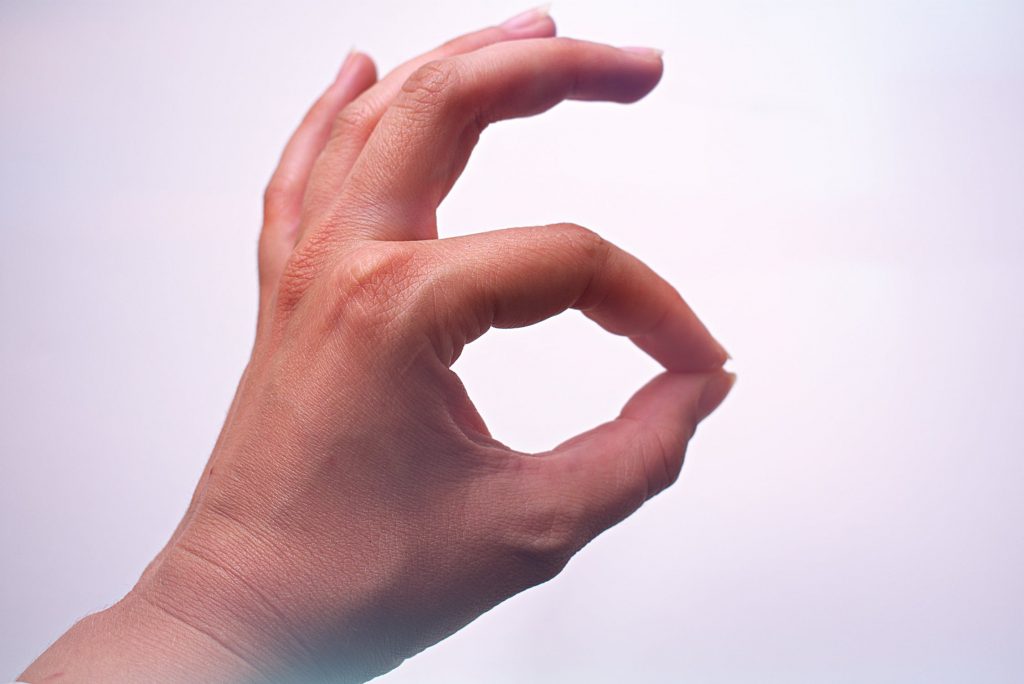Previous studies have shown that healthy individuals, when asked to locate the position of the tips and knuckles of each finger on their hand when it could not be seen, consistently misjudge the size and shape of their hand (Longo & Haggard, 2010). They overestimate the width of their hand and underestimate the length of their fingers. This implies that the judged position of at least some landmarks on the hand (e.g. index finger tip) relative to their actual location is not accurate.
We investigated whether healthy individuals could accurately locate the actual position of their hand when hidden from view. We also investigated whether this accuracy differed dependent on the type of localisation task used (pointing to the landmark or verbally indicating the perceived position on a grid), the orientation of the hidden hand (straight or rotated), and whether the left (non-dominant) or right (dominant) hand was tested.
WHAT DID WE FIND?
The perceived position of the hidden hand was dependent on whether people pointed or verbally indicated the position of their fingertips and knuckles, whether the hidden hand was positioned straight ahead or rotated with respect to their body, and whether the right hand or left hand was tested. Overall, hand position was consistently misjudged as closer to the wrist (a proximal bias of up to 6 cm) and, to a lesser extent, away from the thumb (an ulnar bias of up to 3 cm). Additionally, people continued to misjudge their hidden hand as progressively closer towards the wrist over time, resulting in a proprioceptive drift in the proximal direction. Finally, we replicated the previously reported overestimation of hand width and the underestimation of finger length

SIGNIFICANCE AND IMPLICATIONS
Position sense is one component of proprioception – this includes the innate ability to localise our body parts in space, allowing us to interact with our environment (Proske & Gandevia, 2018). Proprioception is compromised in a wide range of neurological conditions such as stroke (Tyson et al., 2008) and Parkinson’s disease (Vaugoyeau et al., 2011), as well as many orthopaedic conditions such as chronic low back pain (Hodges et al., 2013). At present, there exists a gap between research and clinical settings regarding the assessment of proprioception (Hillier et al., 2015).
One limitation is the complexity, cost and time-consuming nature of proprioceptive measures used in the laboratory. A refined version of the landmark localisation task used in this study offers potential as a simple, quick measurement of one aspect of proprioception. By establishing normative data from healthy populations, future studies could then investigate specific disorders in which proprioception is compromised to determine the validity of the landmark localisation task as a means of differentiating between normal and impaired proprioceptive acuity.
PUBLICATION REFERENCE
Ingram LA, Butler AA, Gandevia SC, Walsh LD. Proprioceptive measurements of perceived hand position using pointing and verbal localisation tasks. PLoS ONE 14: e0210911, 2019.
KEY REFERENCES
Hillier SL, Immink MA, Thewlis D. Assessing proprioception: A systematic review of possibilities. Neurorehabil Neural Repair 29: 1-17, 2015.
Hodges P, Cholewicki J, van Dieen J. Spinal control: the rehabilitation of back pain. Churchill Livingstone, Elsevier; 2013.
Longo MR, Haggard P. An implicit body representation underlying human position sense. Proc Natl Acad Sci USA 107: 11727-11732, 2010.
Proske U, Gandevia SC. Kinesthetic senses. Compr Physiol 8:1157-1183, 2018.
Tyson S, Hanley M, Chillala J, Selley A, Tallis R. Sensory loss in hospital-admitted people with stroke: characteristics, associated factors, and relationship with function. Neurorehabil Neural Repair 22: 166-172, 2008.
Vaugoyeau M, Hakam H, Azulay JP. Proprioceptive impairment and postural orientation control in Parkinson’s disease. Hum Mov Sci 30: 405-411, 2011.
